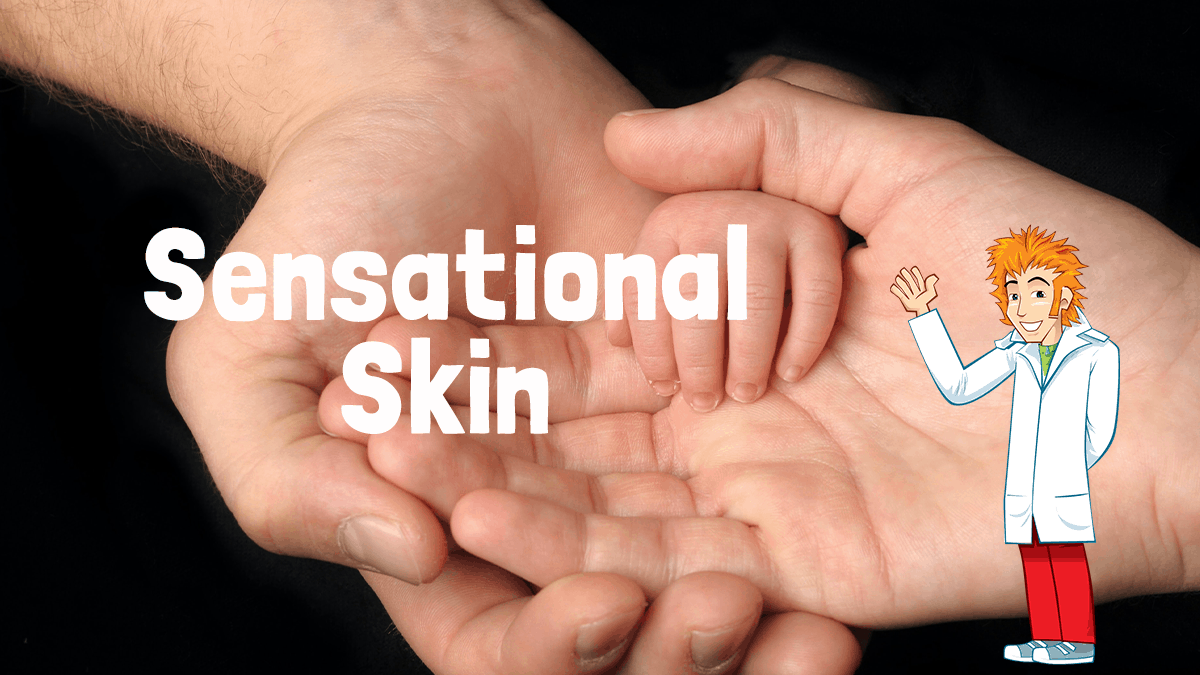 Hello anatomy addicts and welcome to my blog post!
Hello anatomy addicts and welcome to my blog post!
Today Nurse Nanobot and I have been wrapping up our lovely skeleton with skin.
Press the play button above to listen to us explore the world of skin and also read loads of interesting facts below!
Skin is absolutely amazing stuff – as well as keeping our insides inside, it also helps keep our bodies at just the right temperature and allows us to have the sense of touch.
Skin is made up of three layers, each with its own important parts.
Epidermis
The layer that you can see on your body is called the epidermis. It looks smooth and inactive, but it is very important as it keeps you waterproof and stops nasty germs getting into your body. And underneath, new cells are always forming.
It takes a few weeks for new cells to rise to the top of your skin – in fact the whole top layer of your skin is dead by the time it reaches the surface – yuck! You lose nearly 40,000 cells every minute of the day. Scratch your arm gently with a fingernail and you’ll see a trail of white – that’s the dead cells coming away.
Some of your skin cells have the job of making a substance called melanin which gives skin its colour. The darker your skin is, the more melanin you have. Melanin helps protect your skin from the sun’s rays, which is why you get more of it when you sunbathe – that’s what a tan is. You can also help protect your skin when its sunny by putting on suncream, a long sleeve shirt and a hat.
Dermis
Under the epidermis, the next layer is called the dermis. This layer contains nerves endings that help you sense touch, heat and pain. It also has loads of glands that produce sweat and oil, and tough collagen and stretchy elastin which make your skin soft and squishy.
A network of tiny blood vessels in the dermis layer brings nutrients to the skin. You might not be able to see these blood vessels on your body, but they’re easier to see on old people so ask your mum for a look at her hands – hee hee! Don’t tell her I said she was old!
Subcutaneous Layer
The third and final layer is the subcutaneous layer – this holds everything together and acts as a shock absorber. It also contains the fat that keeps you warm.
One of the other fabulous things that skin does is to keep your body at just the right temperature – 37 degrees Celsius. Nerves in the skin sense when it is hotter or colder than this. If it’s hotter, it will secrete sweat from the glands, which takes heat away as it evaporates. Also blood vessels will widen to allow more blood to get to the surface where it can cool down. That’s why we get red faces when we are hot!
And if you’re too cold, the vessels clamp down and hairs stand up to trap in the air. Skin must be one of the cleverest part of your body, I tell you!
Nurse Nanobot’s Orrible Old Anatomy Fact
 Plastic surgery is the name given to surgery to change or repair skin and soft tissues, like burnt skin and wonky noses. It is complicated to do, but people have had lots of practice.
Plastic surgery is the name given to surgery to change or repair skin and soft tissues, like burnt skin and wonky noses. It is complicated to do, but people have had lots of practice.
Two thousand years, people in India were having a go at doing it, on criminals who had had their noses chopped off – a common punishment at that time. They realised it was possible to tidy up what was left of the criminal’s face with skin taken from another part of his body – same principal that surgeon’s use today – clever chaps!
 Disgusting Details
Disgusting Details
If you’re nearly a teenager, you might already have some spots on your face – it’s a common skin condition called acne. It includes whiteheads, blackheads and bumps that are filled with pus. How do they get there? Your skin is covered in tiny holes called pores and hair follicles which hairs grow out of.
These contain an oil called sebum that moistens your hair and skin. Most of the time these glands make the right amount of oil. But every now and again, especially during your teenage years, pores gets clogged up with too much oil, dead skin cells and bacteria, and this can cause acne.
And if you find you’re getting niffy under your arms and in other hot and sweaty places, that’s because smelly bacteria love to eat sweat! To keep spots and sweat under control make sure you have a good wash twice every day, with soap and water.
You can listen to Professor Hallux on:
- Fun Kids Radio
- iTunes
- RSS
- or listen to the series below!





 Fun Kids is on DAB Digital Radio in the UK!
Fun Kids is on DAB Digital Radio in the UK! 


 Listen online -
Listen online - 